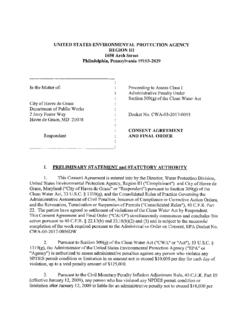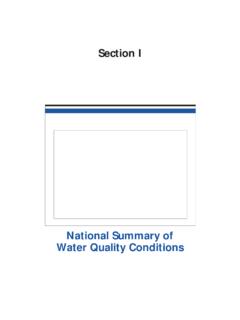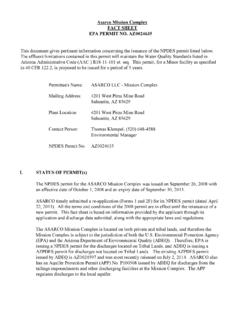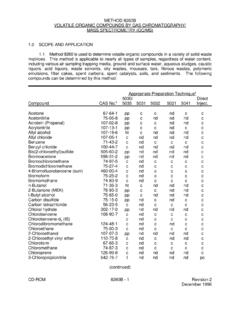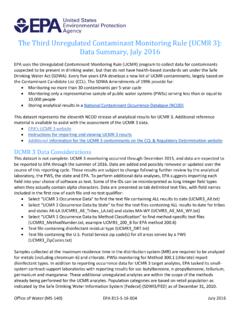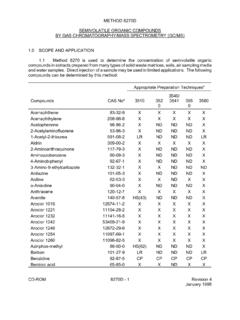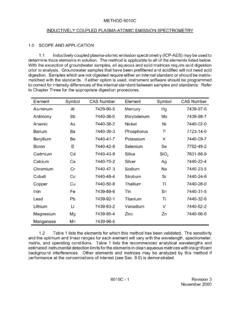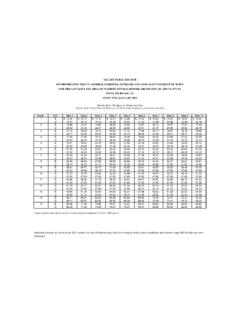Transcription of EPA Method 6020A (SW-846): Inductively Coupled Plasma ...
1 Method 6020A Inductively Coupled Plasma - MASS SPECTROMETRY SCOPE AND APPLICATION Inductively Coupled Plasma -mass spectrometry (ICP-MS) is applicable to the determination of sub- g/L concentrations of a large number of elements in water samples and in waste extracts or digests (References 1 and 2). When dissolved constituents are required, samples must be filtered and acid-preserved prior to analysis. No digestion is required prior to analysis for dissolved elements in water samples. Acid digestion prior to filtration and analysis is required for groundwater, aqueous samples, industrial wastes, soils, sludges, sediments, and other solid wastes for which total (acid-leachable) elements are required.
2 ICP-MS has been applied to the determination of over 60 elements in various matrices. Analytes for which EPA has demonstrated the acceptability of Method 6020 in a multi-laboratory study on solid and aqueous wastes are listed below. Element CASRNa Aluminum Antimony Arsenic Barium Beryllium Cadmium Calcium Chromium Cobalt Copper Iron Lead Magnesium Manganese Mercury Nickel Potassium Selenium Silver Sodium Thallium Vanadium Zinc (Al) (Sb) (As) (Ba) (Be) (Cd) (Ca) (Cr) (Co) (Cu) (Fe) (Pb) (Mg) (Mn) (Hg) (Ni) (K) (Se) (Ag) (Na) (Tl) (V) (Zn) 7429-90-5 7440-36-0 7440-38-2 7440-39-3 7440-41-7 7440-43-9 7440-70-2 7440-47-3 7440-48-4 7440-50-8 7439-89-6 7439-92-1 7439-95-4 7439-96-5 7439-97-6 7440-02-0 7440-09-7 7782-49-2 7440-22-4 7440-23-5 7440-28-0 7440-62-2 7440-66-6 aChemical Abstract Service Registry Number CD-ROM 6020A - 1 Revision 1 January 1998 Acceptability of the Method for an element was based upon the multi-laboratory performance compared with that of either furnace atomic absorption spectrophotometry or Inductively Coupled Plasma -atomic emission spectrometry.
3 It should be noted that one multi-laboratory study was conducted in 1988 and advances in ICP-MS instrumentation and software have been made since that time and additional studies have been added with validation and improvements in performance of the Method . performance , in general, exceeds the multi-laboratory performance data for the listed elements . It is expected that current performance will exceed the multi-laboratory performance data for the listed elements (and others) that are provided in Section Instrument detection limits, sensitivities, and linear ranges will vary with the matrices, instrumentation, and operating conditions.
4 In relatively simple matrices, detection limits will generally be below g/L. Less sensitive elements (like Se and As) and desensitized major elements may be g/L or higher. If Method 6020 is used to determine any analyte not listed in Section , it is the responsibility of the analyst to demonstrate the accuracy and precision of the Method in the waste to be analyzed. The analyst is always required to monitor potential sources of interferences and take appropriate action to ensure data of known quality (see Section ). Other elements and matrices may be analyzed by this Method if performance is demonstrated for the analyte of interest, in the matrices of interest, at the concentration levels of interest in the same manner as the listed elements and matrices (see Sec.)
5 Use of this Method should be relegated to spectroscopists who are knowledgeable in the recognition and in the correction of spectral, chemical, and physical interferences in ICP-MS. An appropriate internal standard is required for each analyte determined by ICP-MS. Recommended internal standards are 6Li, 45Sc, 89Y, 103Rh, 115In, 159Tb, 165Ho, and 209Bi. The lithium internal standard should have an enriched abundance of 6Li, so that interference from lithium native to the sample is minimized. Other elements may need to be used as internal standards when samples contain significant native amounts of the recommended internal standards. SUMMARY OF Method Prior to analysis, samples which require total ("acid-leachable") values must be digested using appropriate sample preparation methods (such as methods 3005 - 3052).
6 Method 6020 describes the multi-elemental determination of analytes by ICP-MS in environmental samples. The Method measures ions produced by a radio-frequency Inductively Coupled Plasma . Analyte species originating in a liquid are nebulized and the resulting aerosol is transported by argon gas into the Plasma torch. The ions produced by high temperatures are entrained in the Plasma gas and introduced, by means of an interface, into a mass spectrometer. The ions produced in the Plasma are sorted according to their mass-to-charge ratios and quantified with a channel electron multiplier. Interferences must be assessed and valid corrections applied or the data flagged to indicate problems.
7 Interference correction must include compensation for background ions contributed by the Plasma gas, reagents, and constituents of the sample matrix. DEFINITIONS Refer to Chapter One and Chapter Three for a listing of applicable definitions. CD-ROM 6020A - 2 Revision 1 January 1998 INTERFERENCES Isobaric elemental interferences in ICP-MS are caused by isotopes of different elements forming atomic ions with the same nominal mass-to-charge ratio (m/z). A data system must be used to correct for these interferences. This involves determining the signal for another isotope of the interfering element and subtracting the appropriate signal from the analyte isotope signal.
8 Since commercial ICP-MS instruments nominally provide unit resolution at 10% of the peak height, very high ion currents at adjacent masses can also contribute to ion signals at the mass of interest. Although this type of interference is uncommon, it is not easily corrected, and samples exhibiting a significant problem of this type could require resolution improvement, matrix separation, or analysis using another verified and documented isotope, or use of another Method . Isobaric molecular and doubly-charged ion interferences in ICP-MS are caused by ions consisting of more than one atom or charge, respectively. Most isobaric interferences that could affect ICP-MS determinations have been identified in the literature (References 3 and 4).
9 Examples include 75 ArCl+ ion on the 75As signal and MoO+ ions on the cadmium isotopes. While the approach used to correct for molecular isobaric interferences is demonstrated below using the natural isotope abundances from the literature (Reference 5), the most precise coefficients for an instrument can be determined from the ratio of the net isotope signals observed for a standard solution at a concentration providing suitable (<1 percent) counting statistics. Because the 35Cl natural abundance of percent is times the 37Cl abundance of percent, the chloride correction for arsenic can be calculated (approximately) as follows (where the 38Ar37Cl+ contribution at m/z 75 is a negligible percent of the 40Ar35Cl+ signal): Corrected arsenic signal (using natural isotopes abundances for coefficient approximations) = (m/z 75 signal) - ( ) (m/z 77 signal) + ( ) (m/z 82 signal), where the final term adjusts for any selenium contribution at 77 m/z, NOTE.
10 Arsenic values can be biased high by this type of equation when the net signal at m/z 82 is caused by ions other than 82Se+, ( , 81 BrH+ from bromine wastes [Reference 6]). Similarly, Corrected cadmium signal (using natural isotopes abundances for coefficient approximations) = (m/z 114 signal) - ( )(m/z 118 signal) - ( )(m/z 108 signal), where last 2 terms adjust for any 114Sn+ or 114 MoO+ contributions at m/z 114. NOTE: Cadmium values will be biased low by this type of equation when 92 ZrO+ ions contribute at m/z 108, but use of m/z 111 for Cd is even subject to direct (94 ZrOH+) and indirect (90 ZrO+) additive interferences when Zr is present.

